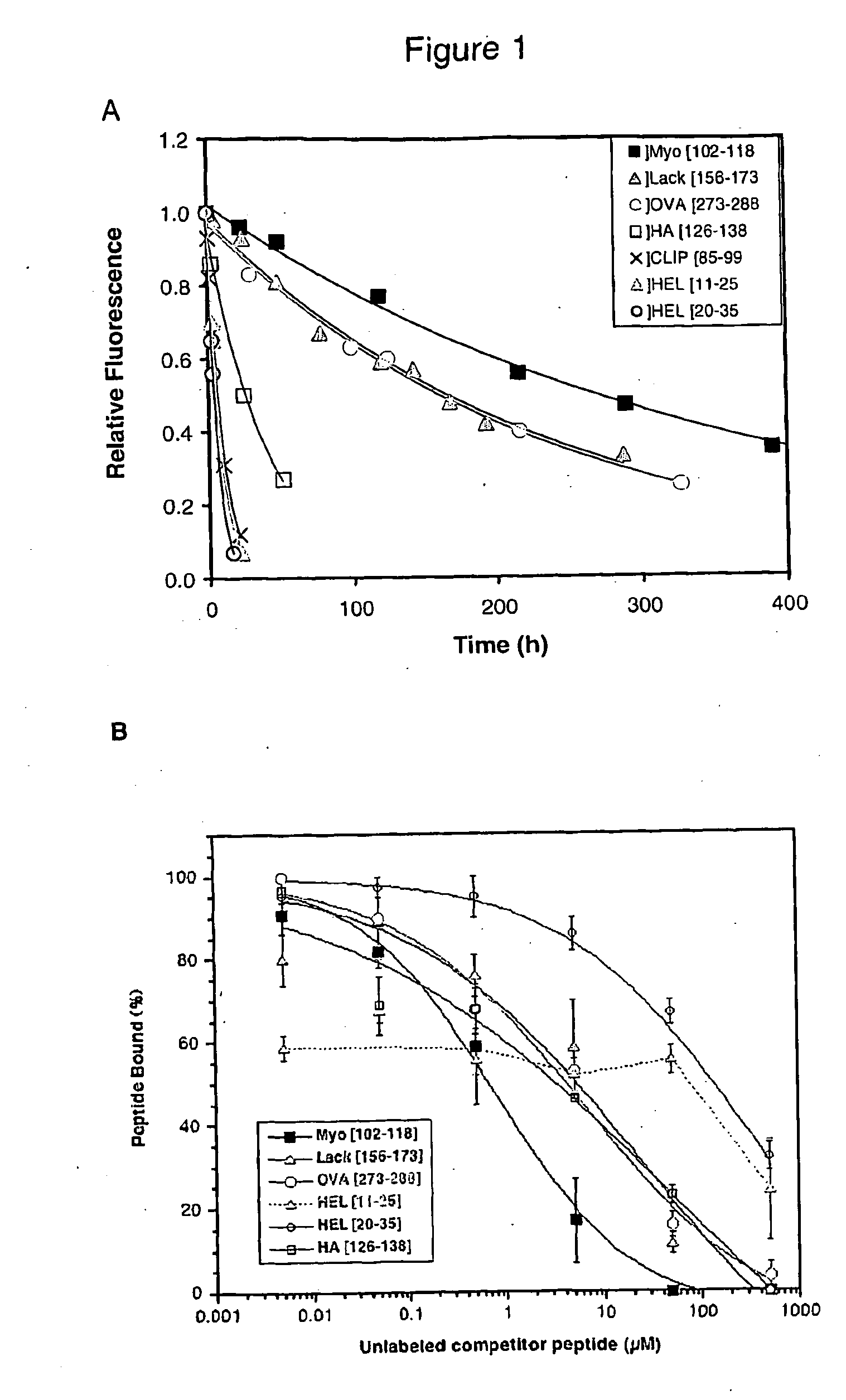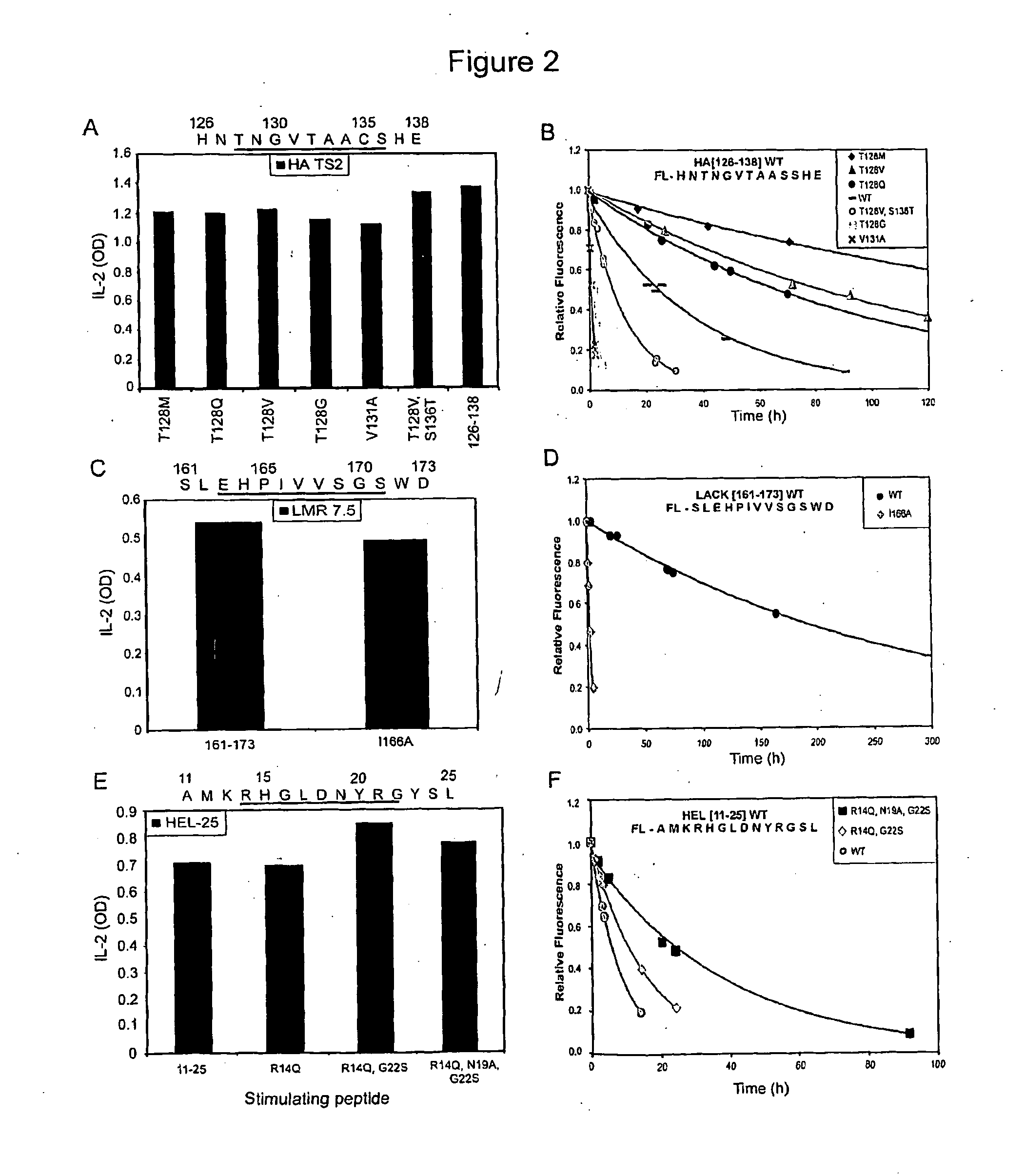Method for Controlling Immunodominance
- Summary
- Abstract
- Description
- Claims
- Application Information
AI Technical Summary
Benefits of technology
Problems solved by technology
Method used
Image
Examples
example 1
Materials and Methods Used
Antibodies and Peptides
[0034]Purified rat anti-mouse IL-2 (JES6-1A12) antibodies and biotinylated rat anti-mouse IL-2 (JES6-5H4) antibodies were obtained from BD PharMingen. Synthetic peptides were obtained either from commercial sources, or were the generous gifts of C. Beeson (Medical University of South Carolina), N. Glaichenhaus (University of Nice), and D. Fowell (University of Rochester).
Purification of Soluble I-Ad Proteins
[0035]A chimeric soluble I-Ad protein (sI-Ad), with a small segment of the carboxyterminal domains of I-A replaced with I-E sequences was used for peptide binding studies. It has been shown that the modifications improve dimer stability but do not affect peptide-binding characteristics of class II molecules (Chaves et al., J. Immunological Methods 300, 74-92, 2005). Transfectants expressing the PI-linked class II molecules used as a source of class II, which was obtained from detergent lysates by antibody affinity chromatography as...
example 2
Kinetic Stability Correlates with Immunodominance
[0042]A set of previously identified cryptic and immunodominant epitopes was assembled and characterized for their relative affinity for class II molecules. I-Ad restricted epitopes from divergent origins were utilized, including sperm whale myoglobin (SWM), hen-egg lysozyme (HEL), chicken ovalburnin (OVA), and L. major (LACK) (Mougneau et al., Science 268, 563-566, 1995; Sercarz et al., Annu Rev Immunol 11, 729-766, 1993). The diversity of these epitopes with regard to processing and structure provided the opportunity to isolate a biochemical characteristic that determined in vivo immunodominance. The potential of both peptide competition and peptide dissociation assays was evaluated to distinguish these epitopes. Both assays have been used to determine the relative strength of class II:peptide interactions (Kasson et al., Biochemistry 39, 1048-1058, 2000; McFarland et al., J Immunol 163, 3567-3571, 1999) (Sette et al., J Immunol 142...
example 3
Derivation of Peptide Kinetic Stability Variants
[0045]It was desired to extend the correlative findings between class II:peptide half-lives and immunogenicity to test whether a causative relationship between these two parameters could be shown. To address this, peptide variants that possessed increased or decreased kinetic stability with I-Ad were sought and then investigated whether changing the kinetic stability of a given class II:peptide complex caused a corresponding change in its immunogenicity in vivo.
[0046]In order to arrive at generalizable conclusions, three unrelated peptides were chosen: the influenza HA [126-138] peptide, the LACK [156-173] peptide from L. major, and hen-egg lysozyme (HEL) [11-25], each of which offered unique biological or biochemical properties. The HA [126-138] peptide was chosen because the crystal structure of HA [126-138]: I-Ad has been solved (Scott et al., 1998), providing the register for the peptide bound to I-Ad. A second advantage of the HA ...
PUM
| Property | Measurement | Unit |
|---|---|---|
| Time | aaaaa | aaaaa |
| Chemical shift | aaaaa | aaaaa |
| Electric potential / voltage | aaaaa | aaaaa |
Abstract
Description
Claims
Application Information
 Login to View More
Login to View More - R&D
- Intellectual Property
- Life Sciences
- Materials
- Tech Scout
- Unparalleled Data Quality
- Higher Quality Content
- 60% Fewer Hallucinations
Browse by: Latest US Patents, China's latest patents, Technical Efficacy Thesaurus, Application Domain, Technology Topic, Popular Technical Reports.
© 2025 PatSnap. All rights reserved.Legal|Privacy policy|Modern Slavery Act Transparency Statement|Sitemap|About US| Contact US: help@patsnap.com



